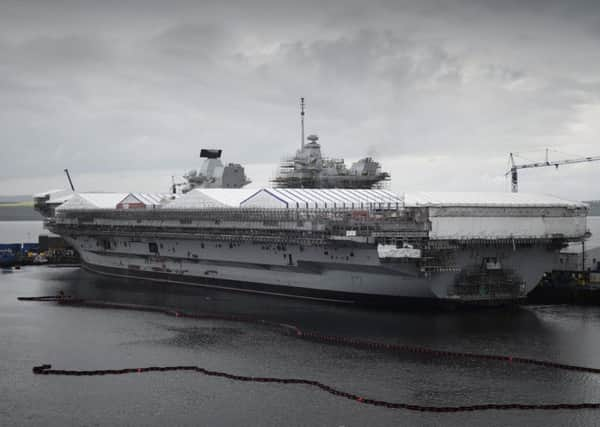Look inside Royal Navy's stunning new carriers as they near switch to Portsmouth


And today, with almost a year until the nation’s newest aircraft carrier HMS Queen Elizabeth berths into her home base at Portsmouth, The News has been given access inside the navy’s new flagship.
The 65,000-tonne leviathan is docked in Rosyth, just a few miles outside Edinburgh and has a veritable army working day and night to finish her.
Advertisement
Hide AdAdvertisement
Hide AdMuch of the work is already completed, with a vast amount of Queen Elizabeth’s war-fighting systems either in place or not far from being fully operational.
Her expansive flight deck, which is almost the size of three football pitches, is today receiving its first coating of a new space-age heat resistant metal.
The thermal coating has been developed specifically by British companies to protect the flight deck of Queen Elizabeth and her sister ship HMS Prince of Wales from the searing heat which results from the immense thrust of the engines of the new F-35B Lightning II fighter jets.
Using a combination of combination of aluminium and titanium, the thermal metal coating can withstand temperatures of up to 1,500°C and is similar to that used to coat the NASA’s space shuttle.
Advertisement
Hide AdAdvertisement
Hide AdIan Booth, managing director of the Aircraft Carrier Alliance which is leading the build of the two new carriers, said this was a key moment in Queen Elizabeth’s development.
“There is incredible momentum behind the programme to prepare HMS Queen Elizabeth for sea trials and integrate the F-35B Lightning II aircraft,’ he said.
‘Working with experts in the UK, we have developed a unique coating to provide the necessary protection to the flight deck of the aircraft carriers and this will ensure they can deliver the UK’s carrier strike capability for the next fifty years.’
Queen Elizabeth is expected to begin sea trial early next year – later than had originally been planned.
Advertisement
Hide AdAdvertisement
Hide AdHowever, she is still expected to arrive in Portsmouth in late spring 2017, with defence sources hinting to The News that this could be as early as May next year.
Captain Simon Petitt, senior naval officer of Queen Elizabeth, has overseen her development for three years.
He is due to leave the ship on Tuesday, handing over the reigns to her first commanding officer, Commodore Jerry Kyd.
Speaking of the flight deck innovation, Captain Petitt said: ‘The new flight deck coating is one of the many 21st Century engineering innovations being incorporated in the Queen Elizabeth Class programme.
Advertisement
Hide AdAdvertisement
Hide Ad‘As the largest warships ever built for the Royal Navy, these powerful ambassadors will protect UK interests around the globe for the next 50 years.’
The specialist thermal coating is being applied to sections of the vast flight deck of the carrier using a specially developed robotic spray, which fires powdered metal through a jet of plasma at temperatures of almost 10,000°C (18,000°F).
The molten droplets then flatten and quickly solidify, creating a tough but rough coating 2-2.5mm thick that is bonded to the steel beneath.
Approximately 2,000 sq m of the 19,000 sq m flight deck will be coated, with the work due to be completed prior to sea trials in early 2017.